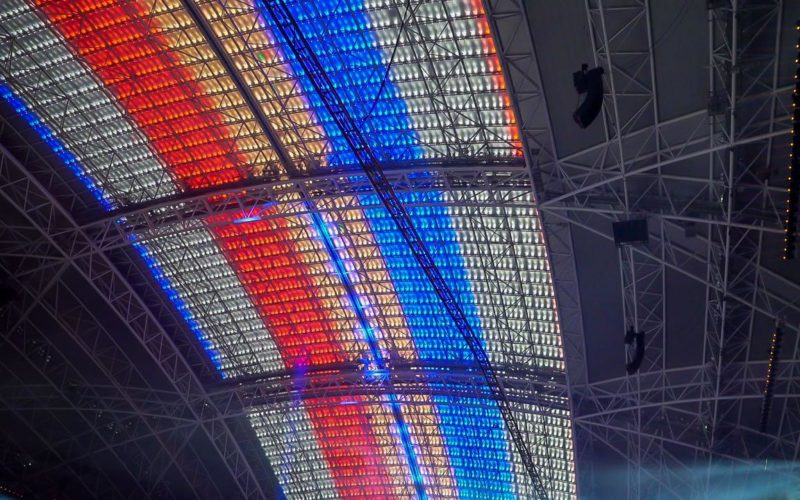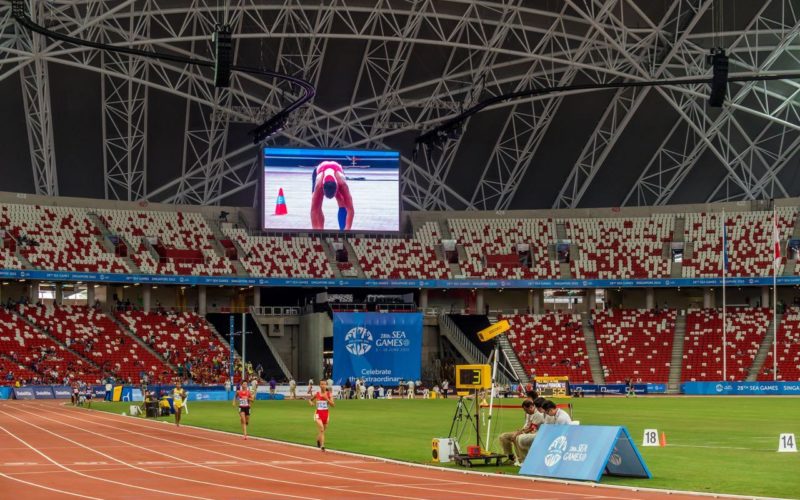The sold-out Opening Ceremony was a three-hour spectacle, where the audience watched more than 5,000 performers and volunteers participating in a breathtaking show at Singapore’s National Stadium, witnessing a new world-record for multimedia projection display that was broadcast live to all the member countries in South East Asia.
For several years, Singapore-based The Show Company (sound rental provider) has used NEXO PA systems for their prestigious events. It all started with NEXO PS15s in 1996, and soon followed with Alphas, GEO S, GEO-T, GEO-D-, the CD subbass series, and lately the new modular line array STM Series, which was delivered in December 2014 and debuted on the ZoukOut Moon Stage rave party in Singapore.
It was also December 2014 when The Show Company initially approached Shah Tahir, the sound designer from the SEA Games committee, to express their interest, identifying the perfect occasion to push the new STM Series modular line array into the Asian limelight.
With the new NEXO STM M28 compact cabinets coming onto the market in the 4th quarter of 2014, The Show Company was able to propose a complete system solution and arranged a speaker demo to the committee. NEXO’s David Hochstenbach and Nicolas Kirsch assisted The Show Company design team of Desmond Fong (Project Director), Jon Sim (Audio Project manager/Chief Systems Engineer), and Jerome Soh (Chief Field Engineer RF Systems).
The committee required a PA system specifically for the opening and closing ceremonies to deliver a high quality sound reinforcement system throughout the stadium, and redundant digital transport system to distribute throughout the venue.
The Show Company had to work with the existing acoustic challenges because of the structural issues of the stadium especially its dome-shape roof, and there was no quick solution to this. The team used NEXO’s NS-1 proprietary software design and modeling software to achieve precise positioning and an optimum result, as NEXO’s Nicolas Kirsch confirms, «the sound is clear and detailed even though that huge dome shaped roof gives a 7 sec reverb time. STM is soooo precise.»
In fact, NEXO had already modelled the stadium a few years back, when Nicolas Kirch, David Hochstenbach and Francois Deffarges prepared a design for a permanent sound installation into the venue. The project was never finalised, but it was a great advantage to have the venue already on file. From this point, it was up to Jon Sim, Head of Audio at The Show Company, assisted by Mark Bollenberg, an NS-1 genius and STM specialist based in Australia, to work out design options that would match the specification given by the SEA Games consultant.
Following his guidelines, Mark and Jon produced designs that could exceed the performance specs while keeping in check the weight and size limitations, as well as additional options that could reduce the equipment, while maintaining the SPL specs, to ease the weight and safety as well as costs aspects.
Initially the sound consultant of the Opening show, Mr Shah Tahir, was sceptical of the STM performance and would only consider a ‘like for like’ match of his initial design, but, after STM was demoed to him during the tender process, he fully understood the amazing SPL, HF throw and low and mid frequency acoustic control capacity of the system, and let the team design for the most clear and efficient design they could based on the STM performance. They eventually settled for the slightly more compact design, considering that SPL was not the main issue but giving top priority to clarity, coverage and weight.
The stages consisted of a Field of Play which encompasses practically the whole field as one big stage, a Music Stage for bands, and a Robot Stage for performances. The Show Company’s responsibility for delivering high-quality audio resulted in an overall design involving 10 flown clusters, 16 groundstacks (12 FOH & 4 In-fill), with PS series speakers for holding areas.
SYSTEM SPECIFICATION
Flown clusters: each with 9x STM M46 mains, 9x STM B112 bass, 4x STM S118 subs and 2x NEXO Universal Amp Racks (NUAR) each, with the NUARs flown behind the clusters to keep speaker cables short and lightweight. These covered the top 2 tiers of seating and the VIP balconies.
Groundstacks: each with 3x STM M28 mains, 2x STM B112 bass and 2x STM S118 subs to cover the first tier seating. These clusters provided same detailed and clear powerful sound but with more vertical splay.
Monitoring: 6 additional groundstacks each with 2x STM M46 mains and 2x STM S118 subs focussed on the performers area, to be used as ‘foldback system’ in case the wireless in-ears of MCs and performers failed.
Finally, PS10R2 delays at the outmost second tier seatings of the North and South stands were used to cover the upper 20~30 rows. More PS15s were deployed for the ‘blind spot’ areas under balconies, and others were distributed in the back of house areas to relay the show and commentary sounds to artists and athletes.
The positions of the clusters were limited by several things:
– The weight limit of the roof, which limited the total weight per cluster to under 2T each, inclusive of motors, and chains (about 60m long).
– For safety, each cluster had to distribute the weight in 3 rigging points, 2 at rear (using the STM Delta Beam), 1 at front.
– The flying props track which circulated all around the field of play
– The various lighting trusses carrying over 600 lamps that had to be positioned in a meaningful way for the show
– The 200+ video projectors at about 36~38m height, shooting from the back of the top stands, onto the field of play to create a giant video mapping effect;
– The sightlines from the top stand, reaching up to 36m high
All in all, the only possible location for the sound clusters was above the general gridline, at about 44m height. This meant aiming distances of 55~60m max, with a vertical splay of 55deg per flown clusters, and 40~50m and 15~20deg per ground stacks.
Within the limit weight and height, it was therefore critical to have sufficient HF power and perfect waveguide control to more than line source (55deg). With its 10deg opening and 4x HF drivers per cab, STM was the best choice around to meet these specifications, as it could open very wide (vertically) without breaking the line source control needed for smooth overlapping and phase accuracy in the horizontal field, and still deliver huge headroom.
In the vertical field from ground to top of highest bleacher, the SPL was +/- 1.5dB, and in the horizontal field, walking across the stadium at low, medium or highest level, the overlap gave nearly flat +/- 0.5dB variations, it was almost impossible to distinguish the source positions, only for the slightly different ‘tone’ when facing the clusters.
Only the far end of 2nd level bleachers were off the direct sound field, and they got treated with 2x PS10R2 to add the HF clarity.
The challenge was not only technical but logistical. To bring so many systems together, additional inventory had to be shipped in from outside Singapore. And the set-up requirements were to provide and commission the sound system at least 2 months before the Opening Ceremony, enabling the performers to have ample time to rehearse. The Show Company was able to provide 48x M46 systems (total 144 modules) and 24x M28 systems (total 48 modules) but that was still short of the 320 modules required. After an introduction to ENGINEERING IMPACT LTD, NEXO’s STM partner in Hong Kong, the two parties quickly agreed to cooperate and, within weeks, the 36x additional M46 systems from ENGINEERING IMPACT LTD set sail for the 3-month job in Singapore.
All that seemed easy enough to handle, but there were complicating issues with rigging the system, as Jon Sim explains, «We were given fixed rigging points due to roof loading which didn’t work in favour of flying arrays. The points were situated on a straight horizontal beam, making it difficult to adjust vertical tilt angles and horizontal aiming.» He continued, “after much research, we managed to offset our rig points on the straight beam to allow us fixed horizontal angles and also solved our array tilt angle.»
This is the first time the STM groundstack clusters had been used in the new National Stadium venue. They proved to be a vital element in this stadium configuration as they allowed coverage for the seats under the balcony, not covered by the flown array. The team also deployed 30x PS15 –R2 speakers at all the tunnels where the participants gathered before entering the stadium.
System management and monitoring was done via NEXO’s ES Monitor interface, with clusters arranged in groups, allowing Jon Sim to keep an eye on all the NXAMPs from his sound control room on Level 5. Since the system was playing at 20~30% of its maximum headroom, there was not much to monitor!
The requirement to have NUARs flown with the clusters was a surprise at first, but made absolute sense. And in the drive to reduce weight, The Show Company wanted to rely on STM’s ‘lightweight bumper’ instead of the full-blown rigging hardware which uses separate NUAR bumpers for individual flying. After a round of idea sharing and concept discussions at local level, Jo Gan from The Show Company came up with a very interesting concept, encouraging NEXO R&D to design a new ‘Rear Extension Bar’ to the standard Lightweight bumper. This provides an anchor point for flying 2x NUAR racks at the back of the cluster, side by side. After a few rounds of QA and tests by NEXO’s Structural Engineer partners in Germany, the design was approved and manufactured to order for The Show Company. This new design has now become a standard fare in the STM artillery and will become a very important feature of future ‘stadium’ setups.
The NEXO Universal Amp Racks (NUARs) were all fitted with the new NEXO NXAES104 Cards thus allowing the integration of AES/EBU signals into the amps and control signals via Ethernet through the Optocore network system. The flown racks were specially configured so they would have control of individual amplifier powers on ground level.
The design of the network system involved deployment of 11 stations of X6RFX and Tp models around the whole stadium with a redundant ring fiber network. These stations allowed the AES/EBU, Analog and Ethernet networks to be controlled via the NUAR remote over a fibre network.
The AES feeds from Optocore nodes to the flown NUARS were in some cases up to 200m long, but the signal was good. The AE104 cards performed flawlessly, with all the patching done on the Optocore GUI.
Jon Sim and The Show Company’s team were duly impressed with the STM system and how it performed. «Overall we were very happy with the results of the system. We have plenty of headroom in the system and the direct sound clarity is amazing even with a reverberation time of 7 seconds.»





























































